Adrian Gonzalez vs. NYY - NESN
This past Tuesday night, I had the great pleasure of taking in the Red Sox/Yankees game at Fenway Park. We were firmly entrenched in the very back of the bleachers, just feet from the Dunkin Donuts sign and a group of rambunctious children cheering on their olde town team.
Sure, there were also some boisterous Yankees fans in the bleachers with us, but they were mostly respectful despite their ugly pinstripe jerseys and Derek Jeter t-shirts. I never really have much conversation with them due to my previously mentioned provinciality and disdain for that team. But one Yankees fan made an interesting comment near the end of the 4th inning: Adrian Gonzalez cannot lay off the curve ball.
That single statement had me wondering if there was any truth to it. Did Gonzo have trouble with that pitch? Was it just a bad night? Was CC Sabathia giving him problems? I couldn’t immediately validate the Yankees fan’s comment, but it certainly gave me something to investigate.
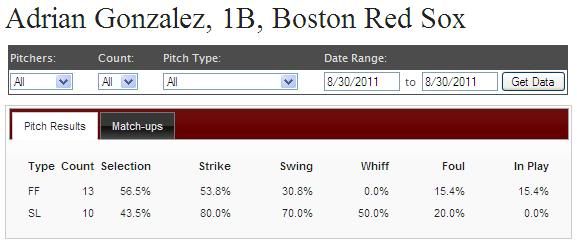
Taking a look at Pitch/fx data, right away we discover that there were zero curveballs thrown to Gonzalez by Sabathia. CC gave Gonzo a steady diet of fastballs and sliders. Sitting 600 feet away from home plate it’s fair to assume that the slider is the pitch our Yankee counterpart was referring to. Recognizing and identifying an off-speed pitch from that distance is pretty tricky, so no-harm, no foul.
Gonzalez had a rough night at the plate going 0-5 with four of those plate appearances coming against Sabathia. In an interview with The Boston Globe, Gonzalez mentioned that the home plate umpire, Ed Rapuano was being very generous to Sabathia with sliders off the plate. This in turn led to Gonzalez having to approach his plate appearances differently.
“I feel that Eddie’s a great umpire,’’ Gonzalez said. “But tonight he was calling pitches off the plate away to lefties, and it made it a lot tougher.’’
Asked what made Sabathia’s slider so effective last night, Gonzalez replied, “You had to worry about the fastball away. You chase those pitches when you’re conscious of a pitch off the plate away that you have to cover.’’
Now we have two forms of confirmation (from Pitch/fx and Gonzalez) that these were not curveballs, so it’s time to investigate Gonzo’s claim that Rapuano was too generous.
Sabathia started Gonzalez off with a first-pitch fastball down the middle that he took for a strike. The second pitch off the AB is where I believe Gonzalez is referring to the expanded strike zone. As you can see pitch #2 was a fastball that is right on the edge of the plate. Brooks Brothers Pitch/fx says it’s a borderline pitch that should be a ball. Texas Leaguers says it was a borderline pitch that should be called a strike.
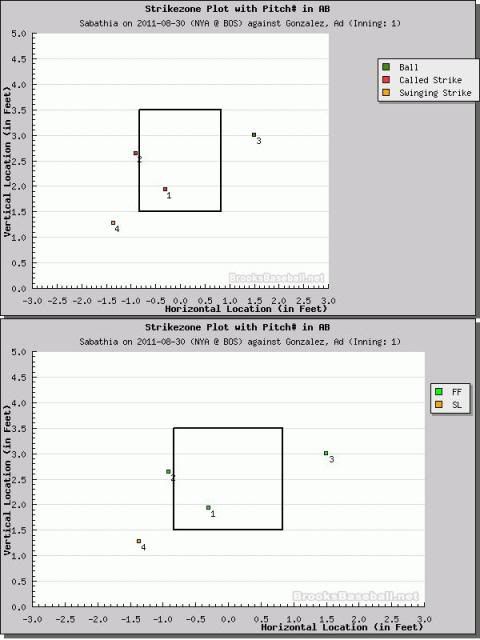
Either way, it’s hardly an expanded strike zone, but Gonzalez was already down 0-2 in the count and he ended up striking out on the fourth pitch of the AB which was a slider well-off the plate. According to Gonzalez, the borderline strike on pitch #2 forced him to chase a slider away.
When Gonzalez came to the plate in the third inning, the bases were empty (thanks to Marco Scutaro trying to stretch a single into a double and getting thrown out). Sabathia started Gonzalez off in AB #2 with a slider down the middle of the plate for called strike one.
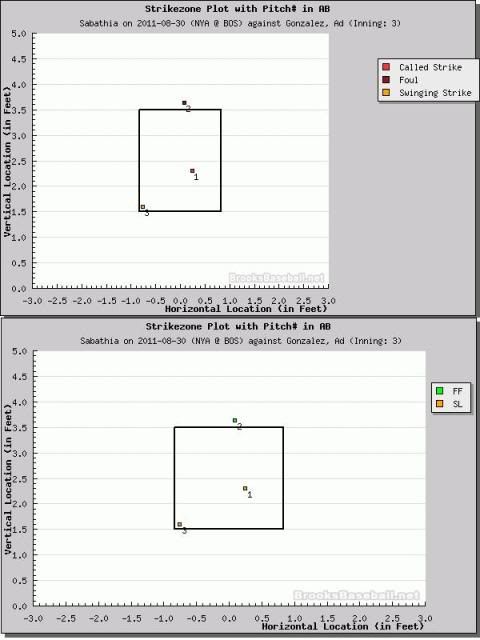
The next pitch was a high fastball that Gonzo fouled off, followed by a swinging third strike on another slider. This time the slider caught the plate and probably left Gonzo shaking his head. Could that fastball-away in the first AB really have gotten into his head this much?
Gonzalez has not had great success against Sabathia, which is hardly surprising given that he is a tough lefty.
You may remember back in May when Gonzalez hit a three-run homer against Sabathia. Gonzalez told Terry Francona he was going to go ‘Ichiro’ on Sabathia because CC had been handling him easily up until that point.
“When pitchers are beating me in,’’ Gonzalez said, “that’s what I do to create a little room inside, to make sure I don’t miss fastballs in.
“He was pounding me in. I wasn’t picking up the ball well. I was swinging at pitches I didn’t want to swing at. It’d be dumb of me to go up and try the same approach again.’’
You can view the awesome home run HERE:
On Tuesday night it seems that once it was in Gonzalez’ head that Rapuano’s strike zone was going to benefit Sabathia, he seemed to lose a bit of pitch recognition and contact ability with CC’s slider.
In the bottom of the 4th inning, when Gonzalez faced Sabathia for the third time in the game, CC started him off with a fastball again. This time, Gonzo was not taking the first pitch. He unfortunately fouled it off though and was in the hole again.
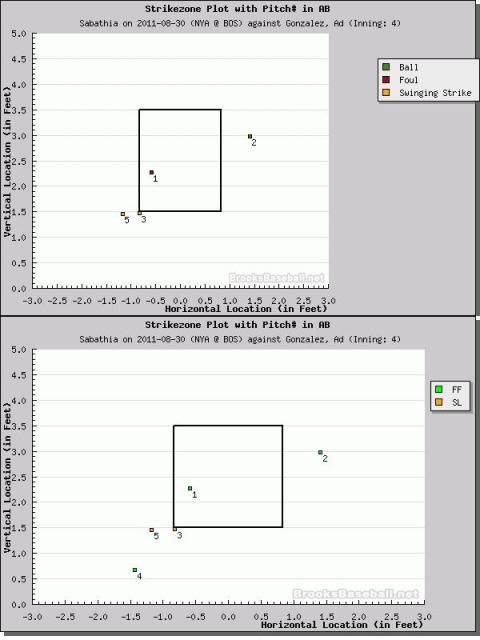
The second pitch was a ball high and inside. Followed by a third pitch slider off the outside part of the plate that Gonzo could not connect with. Pitch/fx said it was a ball. CC’s fourth pitch was a junk fastball in the dirt which set up pitch #5: the slider away for another strikeout. It was the third time that Gonzalez went down by way of the ‘K’.
That AB was particularly disheartening and was a pretty good leverage point in the game. Gonzo had two men in scoring position and the Red Sox had scored two runs that inning already. It was a chance to really blow things open. Instead Gonzo stranded ducks on the pond and then Francisco Cereveli hit a home run to lead off the 5th. Ouch.
In Gonzalez’ final AB against Sabathia, he grounded out to short on a fastball to complete a difficult night against the Yankees starter.
Still though, it was just four ABs against a great left-hander so it’s hard to draw the conclusion that Gonzalez chases or struggles with off-speed stuff. But that Yankees fan still had me wondering what Gonzo’s pitch distribution outcomes looked like.
When we dig a little deeper into some advanced detail, I think we find something quite interesting. Gonzalez has struggled in ’11 with the slider.
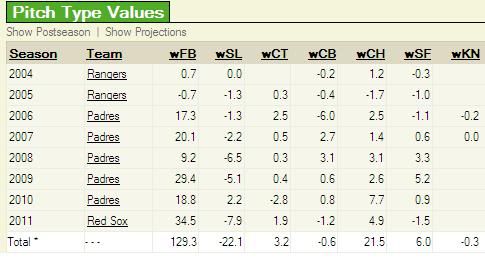
HERE is a little primer on how pitch value is calculated. Basically, you have a value assigned to every outcome pitch. The accumulation of those outcomes is a total weighted value that gives you direct insight into how a pitcher or hitter handles a certain pitch over the course of a season.
From this graphic, you can see that Gonzalez smashes fastballs! In fact, he is second in all of Major League Baseball at 34.5 which trails only Joey Votto who has even more success with heaters at 39.0. Lesson learned? Do not throw Gonzo fastballs.
And as far as the slider is concerned? Gonzalez ranks out as the 6th worst in all of baseball at -7.9. He trails only Miguel Olivo, Garrett Jones, Andre Ethier, Casey McGehee and Alfonso Soriano in handling that pitch in 2011. Soriano is by far and away the worst at -17.7. (I remember when Soriano was a Yankee and he couldn’t handle breaking pitches then either)
So Tuesday night, when that Yankee fan up in the back of bleachers at Fenway Park told me that Gonzalez could not hit curve balls, he wasn’t too far off. Surely he was looking at the breaking ball, but just the wrong one. He was surprisingly correct in his observation.
And if you are an opposing pitcher: Don’t throw Gonzalez fastballs. (Easier said than done)
